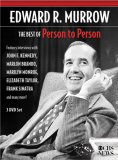| Reviews & Columns |
|
Reviews DVD TV on DVD Blu-ray 4K UHD International DVDs In Theaters Reviews by Studio Video Games Features Collector Series DVDs Easter Egg Database Interviews DVD Talk Radio Feature Articles Columns Anime Talk DVD Savant Horror DVDs The M.O.D. Squad Art House HD Talk Silent DVD
|
DVD Talk Forum |
|
|
| Resources |
|
DVD Price Search Customer Service #'s RCE Info Links |
|
Columns
|
|
|
Edward R. Murrow - The Best of Person to Person
Today, legendary journalist Edward R. Murrow enjoys an almost cult-like admiration from fellow print, radio, and television journalists, particularly due to his overseas radio broadcasts during WWII, and his taking on of Red-baiting Senator Joe McCarthy during the 1950s. Last year, self-described "deep thinker" George Clooney (The Facts of Life, Roseanne) elevated Murrow to mythic status with his biographical treatment of Murrow's life in Good Night, and Good Luck. But for most people during the 1950s, Murrow was probably best known for his popular Friday night celebrity interview program, Person to Person, which ran from 1953 to 1961.
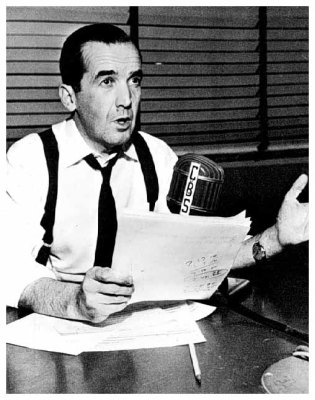
Murrow originally envisioned Person to Person as a showcase for ordinary people who would normally never be the subject of a TV interview. Murrow wanted to give teachers, farmers, police officers, and other average folks a chance to tell their own life stories in an informal chat with Murrow in their homes. However, the network brass at CBS deemed this an impractical idea; it was fine for Murrow to interview people in their homes, but the average television audience, according to CBS, wasn't interested in watching people just like themselves on TV. And so, Murrow was convinced to showcase celebrities and famous people on his show, and celebrity TV journalism as we know it today, was born.
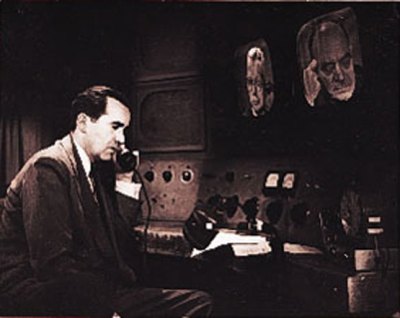
At the time, it wasn't a novel idea to have celebrities provide fodder for the newspapers and television. Gossip columnists like Hedda Hopper and Louella Parsons had been dishing on stars for decades, giving readers and listeners all the scandal and studio-manufactured schmaltz they could handle. But Murrow's idea was unique; he would interview the stars and celebrities on live TV, in their homes (wherever those homes may have been) while Murrow stayed in the CBS studios in New York. Now today, in the age of streaming live video on cell phones, the notion of two people talking live on TV from different parts of the country sounds ridiculously quaint and easy. But not in the 1950's. Huge cables had to be strung throughout the houses and run to relay stations to get the live feed back to New York, while complicated camera moves, made difficult by the cumbersome, bulky cameras, were mapped out so the viewer could follow the star from room to room in the house. It's hard today to conceive how difficult this technical process was, and the novelty of it astounded 1950s audiences ("You mean that's Marlon Brando, right now, in Hollywood, playing the bongos? Right now???)
Of course, there were technical glitches all the time. At the beginning of the Tony Curtis/Janet Leigh interview (included on this disc), the sound feed from New York goes out, leaving Tony to ad lib the first half of the interview (hey, how did he already know what Murrow was going to ask, if this was "spontaneous"? More on that later). Actors who were used to the relatively sedate pace of moviemaking, suddenly found themselves in the chaos of a panicky live TV production, causing many of them to lose their customary composure. Technical challenges weren't the only problems that Person to Person encountered - the critics hated it. For years, Murrow was seen as the standard bearer of integrity and quality for television news, and now suddenly, here he was, making uncomfortable chitchat with Marilyn Monroe, discussing her latest picture. For many, Murrow had sold out (he eventually owned the entire show, and made a fortune off it). Friends close to Murrow claimed he disliked it, too, but continued it because the success of the show enabled him to do the other kinds of programs he liked to do on CBS News.
Viewers didn't seem to mind Murrow settling for discussing Esther Williams' thoughts on the perfect laundry room dimensions (yep, that's here, too). According to most sources, Person to Person was a huge Top Ten hit. Interestingly enough, though, I checked the "bible" of TV information - The Complete Directory to Prime Time Network and Cable TV Shows: 1946 - Present, by Brooks and Marsh - and I found no citation in their yearly lists of the Nielsen Top Thirty for Person to Person (if someone can clear up this seeming contradiction for me, please email me). But let's take it for granted that the show was at least popular enough to not only last for eight years on prime time, but to also attract some of the biggest names in showbiz, as well as artists and thinkers from every field of human endeavor. It's not hard to see why Hollywood came calling to Person to Person; not only did it provide handy publicity for whatever project they current had in the chute, but they were also guaranteed some softball questions from America's favorite journalist, letting America know that despite what they may have read in the scandal sheets, most celebrities were as normal as the audience.
Person to Person really did function as a reassuring, safe, conservative balm for celebrities and for the audience that worshiped them. Murrow's concept of taking viewers into celebrity homes, with no more on his mind than asking what the assorted children's names were, what pictures they had hanging on the wall, where they got their antique furniture from, and what the celebrities did in their leisure time, allowed stars to show their fans that "hey, I may have a lot of money, but really, deep down, I'm just like you." Of course, the image projected out to America was often at odds with what was really going on with the couples shown on Person to Person, and that makes up a lot of the fun one gets from watching Person to Person today. If you're interested in celebrities, it's a great show to watch while you're Googling for further information. A good example is the Esther Williams interview, where she chats with her husband, former singer Ben Gage. Now, I was certainly aware of Esther's career, but I didn't know anything about Gage. He came off quite well in the interview, reminding me of band leader Phil Harris, with the same kind of jovial, easygoing style. But a noticeable tension was there between the couple, so I looked up their story. Apparently (according to Williams' autobiography), Gage was anything but the man that appeared on camera. And that what's fun about viewing Edward R. Murrow: The Best of Person to Person. It's fascinating to watch these celebrities, still somewhat unaware of the power of the camera that is staring at them, gradually reveal themselves to the viewer, despite their best efforts to conceal their real identities.
And their efforts to conceal themselves were of course aided by Murrow and the production team. It seems hard to believe, but some viewers thought these interviews were indeed spontaneous. Evidently, the young television medium was still enough of a mystery that viewers didn't take into account the incredibly difficult logistics that went into mounting such a show. And anyone who's ever had a real conversation with someone will recognize that the celebrities were given the questions beforehand. Not only are the camera moves coordinated with the questions, but it becomes painfully noticeable when Murrow repeatedly skips over guests' answers, when they beg for a follow up. Perhaps most damming for illustrating the show's staged production are the inept jokes that many of the uncomfortable children deliver when Murrow sets them up. When moments of genuine spontaneity do pop up (the incredibly sweet moment when Dean Martin's littlest baby girl hugs her older brother's head), it's apparent that Murrow is taken (delightedly) off-guard. This reliance on staged material (despite CBS's assurance that the answers were not scripted - although they didn't deny they may have been rehearsed beforehand) got Person to Person some bad publicity when the quiz show scandals rocked the industry. Frank Stanton, President of CBS (and no fan of Murrow), accused the show of stacking the deck and lying to its audience. The charges were vigorously denied by Murrow, and the resulting bad publicity hurt both parties. But audiences didn't care; what nobody realized (including Murrow) was that the public, by and large, was smarter than they gave them credit for.
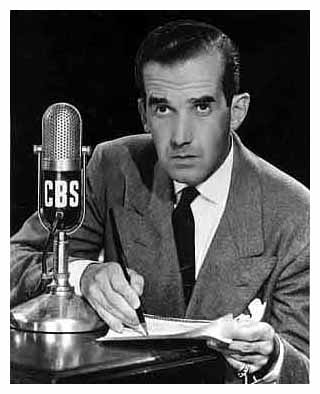
Here are the people interviewed in Edward R. Murrow: The Best of Person to Person, along with my thoughts on each interview:
DISC ONE: AMERICAN ICONS
Dick Clark
A surprisingly square Dick Clark making a case for teenagers and rock n' roll. This was at an early point in Clark's career - he claims to take the public bus to work each day!
Billy Graham
The "Barrymore of the Bible" talks quite a bit about his new home, while the burning intensity of his eyes really put the whammy on you when he starts to talk religion. It's also strange how he looks like a cross between James Arness and Bill Clinton.
Andy Griffith
Perhaps the most natural of all the interviews, Griffith is having a high 'ol time talking to Ed, while his wife sings a lovely folk song. You can still see some of the lingering effects of Griffith playing Lonesome Rhodes.
Oscar Hammerstein
The famous composer is polite and opaque, not giving a lot to the interview.
John F. Kennedy
Surprisingly, this is probably the worst of the interviews on The Best of Person to Person. JFK is quite dull and pedantic (with a grating, halting monotone voice), talking about politics in the driest manner, before reading a passage from "I Have a Rendevous with Death." Too late, JFK - I already beat you to it.
Robert Kennedy
RFK handles the interview chores far better than his brother, but Ethel's stated dislike of the 5th Amendment probably spoiled the effect he was going for. The kids are likeably rowdy, though.
Norman Rockwell
This is a particularly fascinating interview, because Rockwell discusses his process of producing a painting. The interview starts with a eerie shot of downtown Stockbridge, Mass. at night. Handsome family, too, with daughter-in-law Gail a real dish.
Eleanore Roosevelt
Interesting to see what modest accommodations the former First Lady was living in, but her guarded, polished speech doesn't reveal much.
Danny Thomas
I kept waiting for him to be funny, but it didn't happen. The children's answers were strictly rehearsed, and then Danny slips, and shows a slightly creepy side when he tells a story about chasing and "cornering" his son, and getting in one lick with his belt.
Art Linkletter
The homespun host of House Party and People are Funny shows what kind of steely businessman lurks beneath the folksy charm.
Esther Williams
Tension visibly mounts when hubby Ben Gage says Esther doesn't like to be interrupted when talking. She disagrees.
DISC TWO: HOLLYWOOD LEGENDS
Humphrey Bogart and Lauren Bacall
One of the coolest interviews, because it's Bogey. He shows a total mastery of the superficial interview, and Bacall matches him, charmingly insulting him along the way. You can really feel the affection they had for each other.
Marlon Brando
Watch Brando's face when his father says that Marlon was a trouble maker. Bongo drumming follows, while Brando gets lost in the beat. Brando compares his singing to "the mating call of a young yak." This was probably one of the last times that Brando tried to play "by the rules" with Hollywood publicity.
Tony Curtis and Janet Leigh
Tony proves adept at ad libbing when the sound goes out for the first half of the interview. Janet and Tony make a really cute couple.
Bette Davis
Her then-husband, Gary Merrill, isn't mentioned on the box, but he's here, too. A strange interview, where Bette tries to play domestic, but winds up admitting at the last possible moment that being a housewife is monotonous. She gets marks for not keeping the kids up for the interview.
Kirk Douglas
Unfortunately, not a terribly interesting interview. Kirk's usual intensity is nowhere to be found here. He makes a soda for Ed, though.
Charlton Heston
Well spoken, with many literary references, Charlton already seems like an elder statesman, despite his obvious youth here. His interaction with baby son Frasier is quite touching.
Sophia Loren
You can tell she's dying to get out of there. Her favorite things to do? Sleep, swim and relax. Amen to that, Sophia.
Gene Kelly
He's almost impossible to listen to, because his stammering speech is so unfocused. He doesn't have much to say, anyway.
Marilyn Monroe
One of the more bizarre interviews on the discs, Monroe is her usual vague self, while creepy photographer/friend/Svengali Milton Greene giggles strangely from time to time.
Paul Newman and Joanne Woodward
What strikes you at first is how young and eager both of them seem. They have a lot of energy, and they obviously are in love, but some of those looney ideas from Paul really sit you up straight. Still, at least he talks about something serious - a real rarity on these interviews. Too bad Joanne didn't talk more.
Elizabeth Taylor and Mike Todd
It's a shame these two entertaining vulgarians couldn't really bust out and be themselves. You can tell they're chomping at the bit, but 1950's TV decorum holds them back. Could have been the best interview here.
DISC THREE: LEGENDARY ENTERTAINERS
Milton Berle
What starts out funny (with a good joke courtesy of his chauffer), quickly turns maudlin when Uncle Milty begs the audience to understand that all comedians repeat their material. Huh?
Jonathan Winters
It's amazing to see Winter's sweet family, especially when you always think of him existing in this solitary, genius vacuum. Even without letting go, and only working at one-tenth his powers here, he still shows how Robin Williams will never match him.
Sammy Davis, Jr.
Some interesting dynamics are going on with Sammy and his relatives, particularly with his grandmother, who doesn't look like she's too happy with Sammy's behavior.
Jerry Lewis
Here we go. More Buddy Love than Screaming Jerry, Lewis manages to keep it together - just. His kids are adorable and well behaved, too, but Jerry seems preoccupied and tense. Too bad.
Dean Martin
Check out Dean's face when one of his kids blows the comedy line they gave her. It's interesting to hear Dean talk about starting a new phase in his career: dramatic acting. As mentioned above, the moment when Dean's youngest daughter hugs her brother is one of the sweetest, most natural (and unscripted) moments on the disc.
Frank Sinatra
The Chairman of the Board decides not to break Ed's legs when the interview goes according to plan. Watch Frank condescendingly call his two middle-aged servants, "good boys." Cripes.
Sid Caesar
Should have been one of the funniest interviews, but like his wife said, he's not funny around the house. The bit with the deer head is good, though.
Liberace
Has to be seen to be believed. Liberace states not once, but twice, that he's interested in girls.
Okay.
Carol Channing
Carol tells a good story; she's energetic and fun.
Helen Hayes
Helen and her grumpy husband Charles MacArthur make a lovely couple as they talk nostalgically about their home, and all the things in it that were damaged by their kids. It's really a very tender interview, thanks largely to Miss Hayes' emotional honesty.
The DVD:
The Video:
The interviews for Edward R. Murrow: The Best of Person to Person are taken from the surviving film elements of the show, which are kinescopes. Kinescopes were made by placing a 16mm camera in front of a monitor, and filming the live video feed in the studio. Naturally, this isn't the best way to preserve a live performance, but remember, this was before video tape. So the quality of many of the interviews on Edward R. Murrow: The Best of Person to Person are quite rough -- I mean really rough. The Bogart interview in particular, is almost just an iris shot of Bogart's head, with the contrasty white screen haloing around his head. Don't expect pristine black and white images like you'll see in The Honeymooners discs (those were originally filmed on 35mm stock, and safely stored). These are very rough kinescopes, with occasional strobing light effects, so prepare yourself.
The Audio:
The mono soundtrack is adequate for the presentation.
The Extras:
The only thing on Edward R. Murrow: The Best of Person to Person you could call an extra are the bumpers at the beginning and end of each disc, with newsman Bob Schieffer. They're interesting, but extremely brief.
Final Thoughts:
Getting pleasure out of Edward R. Murrow: The Best of Person to Person will depend on how well you already know these stars and their backstories. I read a lot about Hollywood stars, so I was well prepared. My wife didn't know a thing about these people, other than seeing some of their movies, so she wasn't as involved with the interviews. Edward R. Murrow: The Best of Person to Person could really have benefitted with some contextual notes at the beginning of each interview, to give the viewer a grounding for what they're going to see. Still, I'm going to recommend Edward R. Murrow: The Best of Person to Person because it gives the viewer an invaluable look at who was considered important (or at least commercial enough to draw big ratings) during the 1950s, as well as allowing the viewer to decipher possible glitches in the actors' facades so carefully erected for Ed Murrow and the television cameras. Recommended.
Paul Mavis is an internationally published film and television historian, a member of the Online Film Critics Society, and the author of The Espionage Filmography.
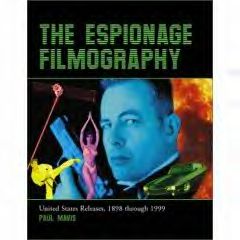

|
| Popular Reviews |
| Sponsored Links |
|
|
| Sponsored Links |
|
|
| Release List | Reviews | Shop | Newsletter | Forum | DVD Giveaways | Blu-Ray | Advertise |
|
Copyright 2024 DVDTalk.com All Rights Reserved. Legal Info, Privacy Policy, Terms of Use,
Manage Preferences,
Your Privacy Choices | |||||||









